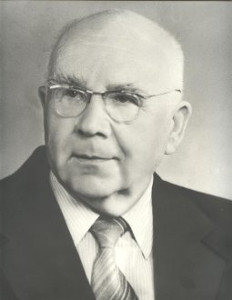
Mikhail G. Veselov
(20.11.1906 - 4.11.1987)
M. G. Veselov was born on 20 November 1906 in the village of Porechye, Kapshinsky county, St. Petersburg province. The son of a peasant, he made his way into science by persistent effort and study. M. G. Veselov's activity was connected entirely with the St. Petersburg (Leningrad) State University, from which he graduated in 1932, and where he began his scientific work under the leadership of the outstanding theoretical physicist, V. A. Fock, a fundamental contributor to the development of contemporary quantum theory. M. G. Veselov was one of Fock's first students and his closest co-worker. Their work together determined Veselov's entire scientific future.
At a moment of M. G. Veselov's entry into science, a leading item on the agenda was the working out of methods of approximation for calculations, working from a basis of the already known general laws and equations of quantum mechanics for several concrete objects, such as atoms and molecules. As V. A. Fock subsequently pointed out, this was a task of a fundamental nature, since exact solutions of Schroedinger's wave equation are obtainable only for the simplest systems. The self-consistent field method, worked out by D. R. Hartree and V. A. Fock in 1932-34, became the basis for the majority of methods of approximation in the theory of systems of many particles in quantum mechanics. However, arising immediately after its creation was a question of its refinement, or to use present-day terminology, of taking into account the correlation effects in particle motion.
One of the first papers to examine the electron correlation in atoms was a joint work of V. A. Fock, M. G. Veselov, and M. I. Petrashen, one of Fock's students. It was devoted to the incomplete separation of variables in the theory of multi-electron systems. This method subsequently became one of the basic methods for describing electron correlation. The two-electron equations obtained in the paper are presently known in scientific literature as the Fock-Veselov-Petrashen equations.
Unfortunately, this work remained insufficiently widely known for a long time. This was the case also for M. G. Veselov's subsequent papers in this cycle (they were published just before the war). However, by the beginning of the 1960s, M. G. Veselov's publications on electron correlation achieved world-wide recognition, and their priority was everywhere acknowledged. Also bringing wide recognition to M. G. Veselov were his papers on the application of the variational method to the statistical model of the atom. On the basis of these investigations he defended his candidate's thesis in 1937, and became one of the first candidates of physical and mathematical sciences (PhD) in the Soviet Union.
In the war years, M. G. Veselov worked on problems of national significance, solving together with V. A. Fock several urgent problems in aerodynamics using the conformal representation method.
After the end of the war and his return to Leningrad, M. G. Veselov put great effort into the organization of the scientific and pedagogical activities of the Leningrad State University Department of theoretical physics. In 1961, he headed the Quantum Mechanics Division. From 1975 on, he headed the Department of theoretical physics of the Scientific Research Institute of Physics at the LSU.
M. G. Veselov's circle of interests in these years was solidly in molecular theory and quantum chemistry. He is justly considered to be one of the founders of quantum chemistry in the USSR. Together with his students, he carried out much important research in the theory of electron properties of molecules. In particular, he was the first to substantiate theoretically the additive scheme of molecular polarizability, and significantly developed the so-called free-electron method, and widely used this method in the calculations of optical, electrical, and magnetic molecular properties.
In the same years, M. G. Veselov continued his research on atomic theory. Together with his students, he created a new method of calculation which made more precise the theory of the outer shells of atoms-the method of adiabatic separation of motions according to velocities. The method quickly won wide popularity among Soviet and foreign experts, and was included in textbooks and monographs on atomic theory. M. G. Veselov also headed the work on compiling tables of analytic wave functions for multi-electron atoms. These tables immediately became a valuable aid for every theoretician working on atomic calculations.
Even this list, which recalls by no means all the scientific directions in which M. G. Veselov's scientific activity developed, gives some idea of his substantial contribution to science. This contribution is especially important in the contemporary phase of the development of atomic and molecular theory, which is characterized by the extension of numerical calculations of various atomic and molecular properties on the basis of intensified and improved methods.
M. G. Veselov's contributions to the development of atomic and molecular theory by no means exhaust his personal contributions. He educated a great company of scientists, doctors, and candidates of physical and mathematical sciencies, who are fruitfully working in various cities of our country.
M. G. Veselov's activity in the introduction of ideas and methods of quantum mechanics into theoretical chemistry is highly valued in specialist circles, both in the USSR and abroad. His book, Elementary Quantum Theory of Atoms and Molecules, which has been translated into five languages, is widely known among physicists and chemists.
For his monograph, "Atomic theory: electron shell structure", published by Nauka in 1986, M. G. Veselov was awarded Leningrad University's first prize.
M. G. Veselov was known as an outstanding lecturer and teacher, as a person with a great feeling of civil responsibility, and as a benevolent and just director. M. G. Veselov's exceptional spiritual qualities, his ability to foster an atmosphere of free creativity and of mutual help and support, were indicative of his beneficial influence, not only on the members of the theoretical departments of Leningrad University, but also on many of its graduates.
The memory of Mikhail G. Veselov will forever remain in the hearts of all who knew this remarkable scientist and person.